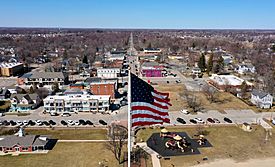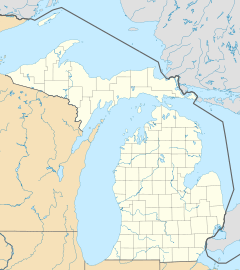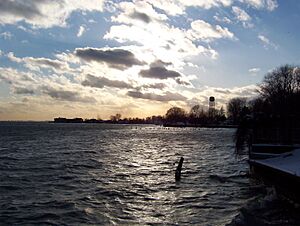New Baltimore, Michigan facts for kids
Quick facts for kids
New Baltimore, Michigan
|
|
|---|---|

Aerial view centered along Washington Street
|
|

Location within Macomb County and the state of Michigan
|
|
| Country | |
| State | |
| County | |
| Settled | 1796 |
| Incorporated | 1867 (village) 1931 (city) |
| Government | |
| • Type | Mayor–council |
| Area | |
| • Total | 6.72 sq mi (17.42 km2) |
| • Land | 4.60 sq mi (11.92 km2) |
| • Water | 2.12 sq mi (5.50 km2) |
| Elevation | 584 ft (178 m) |
| Population
(2020)
|
|
| • Total | 12,117 |
| • Estimate
(2023)
|
11,992 |
| • Density | 2,606.96/sq mi (1,006.04/km2) |
| Time zone | UTC-5 (Eastern (EST)) |
| • Summer (DST) | UTC-4 (EDT) |
| ZIP Code |
48047
|
| Area code(s) | 586 |
| FIPS code | 26-57100 |
| GNIS feature ID | 0633313 |
New Baltimore is a city in Macomb County, Michigan. It is home to about 12,000 people, according to the 2020 census. New Baltimore is a northern part of the Metro Detroit area. It sits right on the northern shores of Lake St. Clair.
Contents
History of New Baltimore
New Baltimore became a village in 1867 and a city in 1931. For a while, it was split between Macomb and St. Clair counties. In the 1970s, the city asked to change the county lines. This made New Baltimore fully part of Macomb County, where it is today. The city is located on the waterfront of Anchor Bay, which is part of Lake St. Clair. It has a public park, a beach, and a downtown shopping area.
Early Inhabitants
Before European settlers arrived, Native American tribes lived along New Baltimore's shoreline for thousands of years. In the 1800s, records show that the land had many ancient burial mounds and earthworks built by people. A researcher named W.B. Hinsdale explored these sites. He wrote about his many discoveries in the early 1900s. Sadly, most of these historical places have been destroyed over time. This happened because of treasure hunters and new buildings. It means much of the city's rich Native American history is now lost.
First European Settlers
The first non-Native American person recorded in the New Baltimore area was Pierre Yax. He was a German explorer born in 1763 in New France (now Michigan). Pierre Yax came to New Baltimore in 1796. He received a land grant signed by President John Quincy Adams in 1826. This grant was based on a land patent Yax had from 1812. At that time, Michigan was still a territory.
Later, other French settlers moved to this area. They built farms along the waterfront and rivers. These farms were long and narrow, stretching inland from the water. Their size was often based on how much land a person could plow in a day.
From Ashleyville to New Baltimore
The first signs of a settled community appeared in 1845. A businessman from Mount Clemens, Alfred Ashley, planned out 60 acres of land. This land was on both sides of Washington Street. It became known as the village of Ashley. In 1851, a post office called Ashleyville opened, with Ashley as the postmaster. Ashley also started businesses in lumber, shipping, and real estate.
The original village of Ashley is now the center of downtown New Baltimore. It stretched along Clay, Base, and Maria Streets from Anchor Bay. The land was divided into a grid pattern, common in American towns back then. Over the years, this pattern became uneven. This was due to a lack of local rules and conflicts with older French land claims. These issues, especially along the waterfront, still affect the city today. The settlement kept Ashley's name until 1867, when it was renamed New Baltimore.
Changing Economy and Transportation
For a long time, New Baltimore's economy was connected to its waterfront. The city used its port to ship farm goods and manufactured products. The area was known for making barrels, brooms, bricks, coffins, corsets, and dairy products. Lumber and building materials were also shipped from local mills by boat. Development was focused on the waterfront, with long shipping piers going into the lake.
As cars became more popular, travel patterns changed. Goods were no longer shipped by water, and the waterfront slowly changed. Between 1860 and 1880, New Baltimore changed from a manufacturing town to a popular resort area. It became a thriving community in Macomb County. Many people from Metro Detroit came here for vacations. The city had an opera house, hotels, and salt baths. It offered summer and winter fun, saloons, a brewery, and many shops.
A steam locomotive line ran through the city in the late 1800s. It connected Detroit and Port Huron. Later, the city built an electricity plant for inter-urban passenger trains. These trains ran until the mid-1920s. Today, you can reach the city using Interstate 94.
Michigan's Tallest Flagpole
In 2015, the historic New Baltimore water tower was taken down. A new landmark was put in its place: Michigan's tallest flagpole. This flagpole stands 160 feet tall on the shores of Anchor Bay at Walter and Mary Burke Park. The New Baltimore Lions Club raised over $100,000 for the flagpole. They wanted to create a landmark for boaters. A special ceremony to dedicate the flagpole took place in October 2016.
Geography
New Baltimore is located in the eastern part of Macomb County. Its eastern edge is the border with St. Clair County. The city is on the northern shore of Anchor Bay, which is the northernmost part of Lake St. Clair.
Highway M-29 goes through the city as Main Street. It leads east about 14 miles to Algonac on the St. Clair River. To the west, it goes about 4 miles to Interstate 94 in Chesterfield Township. New Baltimore is about 10 miles northeast of Mount Clemens, which is the county seat of Macomb County.
The city covers a total area of about 6.73 square miles. About 4.60 square miles of this is land, and 2.12 square miles, or 31.6%, is water.
Population Information
| Historical population | |||
|---|---|---|---|
| Census | Pop. | %± | |
| 1880 | 1,024 | — | |
| 1890 | 865 | −15.5% | |
| 1900 | 922 | 6.6% | |
| 1910 | 920 | −0.2% | |
| 1920 | 974 | 5.9% | |
| 1930 | 1,148 | 17.9% | |
| 1940 | 1,434 | 24.9% | |
| 1950 | 2,043 | 42.5% | |
| 1960 | 3,159 | 54.6% | |
| 1970 | 4,132 | 30.8% | |
| 1980 | 5,439 | 31.6% | |
| 1990 | 5,798 | 6.6% | |
| 2000 | 7,405 | 27.7% | |
| 2010 | 12,084 | 63.2% | |
| 2020 | 12,117 | 0.3% | |
| 2023 (est.) | 11,992 | −0.8% | |
| U.S. Decennial Census | |||
In 2010, there were 12,084 people living in New Baltimore. These people lived in 4,434 households. About 41.3% of these households had children under 18 living there. Most households (60%) were married couples.
The average age of people in the city was 37.1 years old. About 28.8% of residents were under 18. About 9.8% of residents were 65 years or older. The population was almost evenly split between males (48.9%) and females (51.1%).
Notable People from New Baltimore
New Baltimore has been home to several interesting people:
- Butch Hartman, an animator who creates cartoons.
- Roy Kellerman, a Secret Service agent.
- Kathleen Rose Perkins, an actress.
- Claudia Schmidt, a folk singer.
- Tom Stanton, a writer.
See also
 In Spanish: New Baltimore (Míchigan) para niños
In Spanish: New Baltimore (Míchigan) para niños




